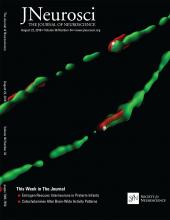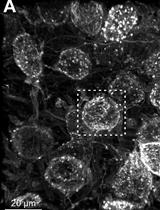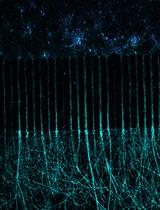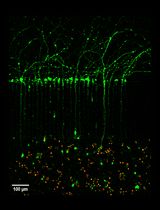- EN - English
- CN - 中文
Primary Embryonic Rat Cortical Neuronal Culture and Chronic Rotenone Treatment in Microfluidic Culture Devices
原代胚胎大鼠皮质神经元培养并长期在微流控培养装置中鱼藤酮处理
发布: 2019年03月20日第9卷第6期 DOI: 10.21769/BioProtoc.3192 浏览次数: 6615
评审: Oneil G. BhalalaSébastien GillotinAnonymous reviewer(s)
Abstract
In the study of neurodegenerative diseases, it is imperative to study the cellular and molecular changes associated with pathogenesis in the relevant cell type, central nervous system neurons. The unique compartmentalized morphology and bioenergetic needs of primary neurons present complications for their study in culture. Recent microculture techniques utilizing microfluidic culture devices allows for environmental separation and analysis of neuronal cell bodies and neurites in culture. Here, we present our protocol for culture of primary neurons in microfluidic devices and their chronic treatment with the Parkinson’s disease (PD) relevant toxicant rotenone. In addition, we present a method for reuse of devices for culture. This culture methodology presents advantages for evaluating early pathogenic cellular and molecular changes in neurons in a compartment-specific manner.
Keywords: Primary neuron cultureBackground
Studying primary neurons in vitro has long presented challenges due to the unique, diverse morphologies of neurons, and due to neuronal culturing requirements (Millet and Gillette, 2012). Neurons exhibit a unique compartmentalized morphology, with the soma, dendrites, and axons all exhibiting compartment-specific biochemical needs (Van Laar and Berman, 2013). Studying these different microenvironments objectively via large-scale approaches or high-throughput methods can be difficult under traditional plate culture, as cell bodies and neurites growing in proximity often cross, overlap, and functionally connect with one another. The development of microculturing methods incorporating microchannels to restrict cell movement and permit neurite outgrowth has allowed for the culturing of neurons in a manner that environmentally separates axonal and dendritic neurite projections from their cell body, or soma (Millet and Gillette, 2012; Taylor et al., 2003). This innovation permits cellular compartment-specific analyses of neuronal development, biochemistry, and effects of treatments (e.g., treating the axons with a drug or toxicant, but not the soma) (Taylor et al., 2005 and 2015; Park et al., 2006). The commercial availability of such devices now allows for uniform, large-scale studies into comparisons of the axonal environment and the somal environment.
By allowing for prolonged, healthy culture of primary neurons while isolating the microenvironments of the differing cellular compartments, these devices have become essential tools for studies that examine morphological-compartment specific development, senescence, or, in the case of our previous study, chronic drug exposure (Van Laar et al., 2018).
Here, we present our detailed protocol for preparation of embryonic rat primary cortical neurons (Arnold et al., 2011; adapted from Ghosh and Greenberg, 1995), culturing the neurons in Xona Microfluidics® brand microfluidic culture devices, and chronically treating the neurons with sublethal levels of the PD-relevant toxicant rotenone, as described in our recent publication in Van Laar et al. (2018). Our microfluidic device plating protocol, adapted from work originally presented by Park et al. (2006), provides details to (1) better ensure isolation of the soma from the axonal compartment side during the initial plating and (2) to promote neuronal health during prolonged culturing and treatment requiring media changes. We also present our protocol for the cleaning and reuse of microfluidic culture devices. This helps prevent the waste of devices in the event that initial platings of neuronal cultures fail to thrive or are otherwise unusable for experimental analyses.
Materials and Reagents
- Materials
- 6 cm sterile culture Petri dishes (Fisher, catalog number: AS-4052)
- 10 cm sterile culture Petri dishes (Corning, catalog number: 430167)
- 15 cm sterile culture Petri dishes (Corning, catalog number: 430599)
- 10 ml sterile syringes (BD, catalog number: 309604)
- PES 0.22 µm-pore sterile syringe filters (Millipore, catalog number: SLGP033RS)
- Sterile 0.22 µm Bottle-Top Filters (Fisher, catalog number: 09-761-112)
- Media Storage Bottles, 500 ml, 1,000 ml (Fisher, catalog numbers: 06-414-1C, 06-414-1D)
- Hydrion pH paper (Fisher, catalog number: 14-853-150N)
- 15 ml Falcon Conical Tubes (Fisher, catalog number: 14-959-70C)
- 50 ml Falcon Conical Tubes (Fisher, catalog number: 14-959-49A)
- 40 µm Sterile Cell Strainer (Fisher, catalog number: 22363547)
- Animal
E18 Pregnant female Sprague-Dawley rat - Primary neuron dissection
- Sodium sulfate (Na2SO4) (Sigma, catalog number: S5640-500G)
- Potassium sulfate (K2SO4) (Sigma, catalog number: P8541-1KG)
- Magnesium chloride (MgCl2), 1 M solution (Sigma, catalog number: M1028-100ML)
- Calcium chloride, anhydrous (CaCl2) (Sigma, catalog number: C5670-500G)
- HEPES, 1 M solution (Gibco, catalog number: 15630-080)
- Glucose (Gibco, catalog number: 15023-021)
- Phenol Red (Sigma, catalog number: P0290-100ML)
- Sodium Hydroxide (NaOH), 10 N (Ricca Chemical, catalog number: 7470-32)
- Cell-culture grade sterile water (Hyclone, catalog number: SH30529.03)
- Hanks’ Balanced Salt Solution (HBSS), 10x (Sigma, catalog number: H1641-500ML)
- Sodium bicarbonate (NaHCO3) (Sigma, catalog number: S5761-500G)
- L-Cysteine hydrochloride monohydrate (Cysteine-HCl) (Sigma, catalog number: C7880-100G)
- Papain (Worthington Biochemical Corp, catalog number: LS003126)
- Cell-culture grade sterile water (Hyclone, catalog number: SH30529.03)
- Bovine Serum Albumin (BSA), Fraction V (Fisher, catalog number: BP1600-100)
- Soybean Trypsin Inhibitor (Sigma, catalog number: T6522-1G)
- Phosphate Buffered Saline (PBS), 10x Solution (Fisher, catalog number: SH3037803)
- 1x PBS Solution (diluted from 10x PBS using cell-culture grade sterile water)
- Paraformaldehyde (PFA) (Fisher, catalog number: AC416780030)
- HBSS Dissection Media (store at 4 °C for up to 3 months) (see Recipes)
- Dissociation Media (store at 4 °C for up to 3 months) (see Recipes)
- L-Cysteine 50x Stock (see Recipes)
- Papain Dissociation Solution and Inhibitor Solutions for Isolation of Primary Rat Cortical Neurons (make fresh on the day of use) (see Recipes)
- Enzyme Solution
- Heavy Inhibitor Solution
- Light Inhibitor Solution
- 4% PFA Solution (see Recipes)
- Plating and culture media
- Neurobasal Media (Gibco, catalog number: 21103-049)
- Fetal Bovine Serum, Heat-Inactivated (Hyclone, catalog number: SH30070.03HI)
- B27 Media Supplement, 50x (Gibco, catalog number: 17504-044)
- Glutamax (Gibco, catalog number: 35050-061)
- Penicillin/Streptomycin Antibiotic Solution (Gibco, catalog number: 15140-122)
- Cortical Neuron Media for Seeding (store each at 4 °C for up to 10 days) (see Recipes)
- Cortical Neuron Media for Feeding (store each at 4 °C for up to 10 days) (see Recipes)
- Microfluidic device preparation, culture, and reuse
- Xona Microfluidics® microchannel culturing microfluidic devices
- 450 μm microgroove barrier Standard Neuron Device (Xona Microfluidics, catalog number: SND450)
- 900 μm microgroove barrier Standard Neuron Device (Xona Microfluidics, catalog number: SND900)
- Corning cover glass coverslip (Corning, catalog number: 2975-244)
- Poly-D-Lysine hydrobromide, MW 70,000-150,000 (Sigma, catalog number: P0899-50MG)
- Boric Acid (Fisher, catalog number: S79802)
- Borax, Anhydrous (MP Biomedicals, catalog number: 190309)
- HCl, 12 N (Fisher, catalog number: A144-500)
- Cell-culture grade sterile water (Hyclone, catalog number: SH30529.03)
- RBS detergent solution (Thermo, catalog number: 27950)
- 100% Ethanol (Decon Labs, catalog number: 2705HC)
- 0.1 M Borate Buffer Solution (see Recipes)
- Poly-D-Lysine 2.5 mg/ml Stock Solution (see Recipes)
- Poly-D-Lysine 100 µg/ml Coating Solution (see Recipes)
- Xona Microfluidics® microchannel culturing microfluidic devices
- Rotenone treatment
- DMSO (Sigma, catalog number: D2438)
- Rotenone (Sigma, catalog number: R8875-1G)
- Rotenone Stock Solution (see Recipes)
- Rotenone 2x and 1x solutions (see Recipes)
- DMSO Vehicle Control 2x and 1x solutions (see Recipes)
Equipment
- CO2 tank
- CO2 single-stage flowmeter regulator (Western Medica, model: M1-320-12FM)
- CO2 gas anesthetizing Box (Braintree Scientific, model: AB-2)
- Motic Dissection microscope (Motic, model: SMZ-168)
- Roboz surgical instrument dissection tools
- Dumont #5 Forceps, Straight tip (Roboz, catalog number: RS-5060)
- Dumont #5 Forceps, 45 Degree tip (Roboz, catalog number: RS-5005)
- Straight, Sharp-Blunt Operating Scissors (Roboz, catalog number: RS-6812)
- Extra Fine Micro Dissecting Scissors (Roboz, catalog number: RS-5882)
- Micro Dissecting Spring Scissors (Roboz, catalog number: RS-5603)
- Sorvall Legend T table-top centrifuge (Thermo, model: 75004367)
- Nuaire Class II Type A2 Laminar-flow sterile culture hood with vacuum waste system (Nuaire, model: NU-425-400)
- Leica Fiberlight light source (Leica, model: EEG2823)
- Olympus light microscope (Olympus, model: CKX31)
- HeraCell CO2- and Temperature-Controlled culture incubator (Thermo, model: 51022394)
- Isotemp 110 Heated Water Bath (Fisher Scientific, model: 15-460-10)
- Wheaton Glass Slide Staining Jar (Fisher Scientific, model: 22-309-247)
- Disposable transfer pipettes (Fisher Scientific, catalog number: 13-711-20)
- Rocking Shaker Plate (Labnet, model: S-2035)
- Heated Stir Plate (Corning, model: PC-420)
- Accumet basic pH meter (Fisher Scientific)
- Vortex Mixer (Labnet, model: VX100)
- Scale (Denver Instruments, model: APX-100)
- Millipore Milli-Q Ultrapure Water System
- Assorted mechanical pipettes and corresponding sterile tips
- Hemocytometer and Cell Counter
- Thermometer
- Autoclave
- Chemical Fume Hood
- 4 °C refrigerator
- -20 °C freezer
- -80 °C freezer
Procedure
文章信息
版权信息
© 2019 The Authors; exclusive licensee Bio-protocol LLC.
如何引用
Readers should cite both the Bio-protocol article and the original research article where this protocol was used:
- Van Laar, V. S., Arnold, B. and Berman, S. B. (2019). Primary Embryonic Rat Cortical Neuronal Culture and Chronic Rotenone Treatment in Microfluidic Culture Devices. Bio-protocol 9(6): e3192. DOI: 10.21769/BioProtoc.3192.
- Van Laar, V. S., Arnold, B., Howlett, E. H., Calderon, M. J., St Croix, C. M., Greenamyre, J. T., Sanders, L. H. and Berman, S. B. (2018). Evidence for compartmentalized axonal mitochondrial biogenesis: mitochondrial DNA replication increases in distal axons as an early response to Parkinson's disease-relevant stress. J Neurosci 38(34): 7505-7515.
分类
神经科学 > 细胞机理 > 组织分离与培养
细胞生物学 > 细胞分离和培养 > 微流体细胞培养
您对这篇实验方法有问题吗?
在此处发布您的问题,我们将邀请本文作者来回答。同时,我们会将您的问题发布到Bio-protocol Exchange,以便寻求社区成员的帮助。
Share
Bluesky
X
Copy link












